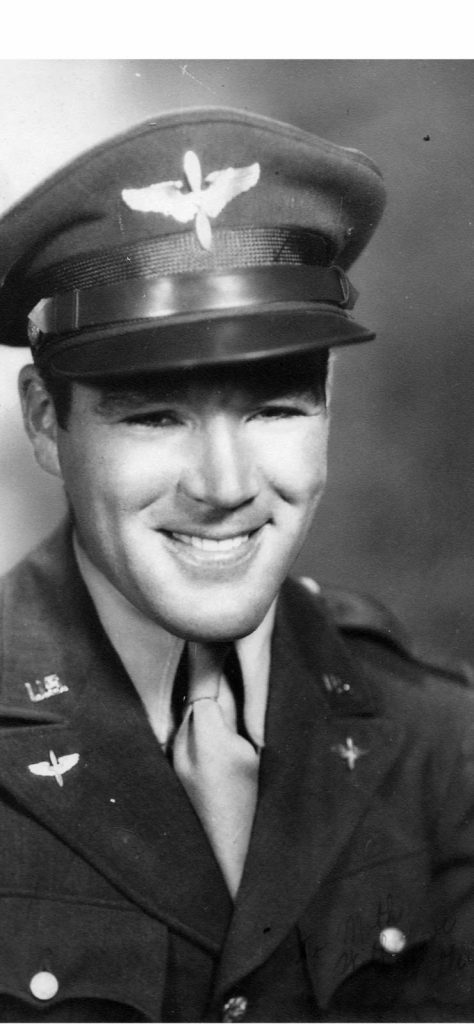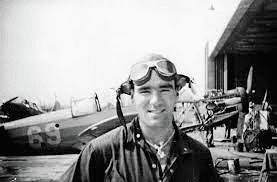(Editor’s Note: Wayne Riley, of Jasper, Ga., contacted The Advocate Newspapers, Inc., parent company of The Saugus Advocate, early last month after reading this 1999 two-part series written by longtime Saugus writer and lifelong town resident Janice K. Jarosz on the Internet. It was part of the research he did to find out about Walter J. Daniels, the World War II hero from Saugus, who once owned the footlocker he recently purchased in a Georgia thrift store. Mrs. Jarosz, a frequent contributor to The Saugus Advocate, gave permission for the articles she wrote – published in the now-defunct Saugus Advertiser on March 29 and April 4, 2019 – to be reprinted in this week’s paper.)
In 1993, singer David Bowie wrote a song about wanting to be a hero, “just for one day.” He sang, “We can be heroes if just for one day.”
The late Walter Daniels, of Saugus, was a genuine hero for most of his life, but it was only years later that his family learned of his war record as a pilot for the famous “Flying Tigers.”
A dedicated family man, community leader, and loyal friend to many, Walter’s family thought they knew all about him for a long time. They knew that he served during World War II but never shared with them the true extent of his career. That was until a chance meeting at a reunion with his war buddies when his family learned of the late Walter’s “Flying Tiger’s” war record.
Walter was born at home, in the Cliftondale section of town into a large family of 11 children. There was Frank, Bill, John, Laurence, Charles, Carol, Dorothy, Gertrude, Millie, and Alice. His younger years were spent much the same as most of us; he helped in the care of his brothers and sisters, played football for Saugus High School and graduated in 1931.
After school, he worked at various jobs for several years and eventually enlisted in the Army Air Force on Jan. 16, 1942. He received his wings in Texas and underwent extensive combat training in Kracki [Karachi], India.
After his tour of duty, Walter was discharged from the service on Nov. 30, 1945, and returned to Saugus. The war had ended, and Walter was ready to start a new life.
At approximately the same time in another part of the world, Virginia Linehan, a young and beautiful girl who was soon to be married, was concerned for her girlfriend, also named Virginia, who was going through an engagement breakup. Virginia suggested that they go out for the evening in the hopes of cheering up her heartbroken friend.
Virginia took her to the Oceanview Ballroom in Revere, which is now known as Wonderland Ballroom. In the ’40s, the most popular form of entertainment and the best way to spend time was dancing, and both girls loved to dance!
Even in her later years, Virginia could still feel the tap on her shoulder as she sat watching other couples dance by. It was when she turned to see who it was that she first laid eyes on her soon-to-be husband, Walter. He was handsome, a great dancer, and as Virginia often said, “he just literally swept me off my feet.”
Within two years they were married and eventually settled in Saugus. Several years later, the couple purchased a home on Pleasant Street and three children, Walter, Jr., Laurence, and Susan completed the family.
Sadly, a terrible tragedy struck the family in 1958 when their 4-year-old son Laurence was killed in an accident. Young Laurence was named in memory of his father’s brother, who was killed in World War II at 19 years of age.
For approximately six years, Walter served as an MDC policeman. He eventually took the civil service exam for the position of building inspector for the town of Saugus, and after topping the list, Town Manager John Stinson appointed him to the position.
Mr. Daniels served as building inspector for 10 years and during his tenure, the town was hit with several large fires, one being the former high school in Saugus Center. He coordinated the disaster response, was in charge of the cleanup and oversaw the renovation of the addition that was spared.
All of this was accomplished without much fanfare, but the stress of the job took its toll. In 1963, Mr. Daniels suffered a heart attack and was advised to scale back some of his responsibilities.
After a bit of a rest, he left his local position and became a state building inspector for a few more years until he was forced to retire due to ill health.
Walter Daniels passed away at the age of 61, after a lengthy illness. In his obituary it stated that he served as a Town Meeting member for several years, a member of the VFW, and a longtime member of the Saugus Lions Club. The notice also included a small outline of his service record.
Anyone who knew Walter during his lifetime knew that he was a good family man, a dedicated town official, and had served his country well. But it wasn’t until years after his death that the true depth of his character, together with an impressive war record, was revealed.
Part Two – A hero for more than one day
Several family members, his nephews, Peter Daniels and Eddie Moore, along with Ed’s son Walter, were invited to attend a reunion with their uncles’ war buddies several years ago and it was at that reunion when his family discovered another amazing side of their uncle.
What the family learned was that there were books written about him, that he saved many fellow pilots during combat and that he flew over 100 missions for the Flying Tigers.
According to a book written by Donald S. Lopez entitled, “Into the Teeth of the Tiger,” Walter was a member of the Flying Tigers Squad of pilots who participated in one of the most remarkable air campaigns of World War II in the war against the Japanese in China.
“God is my Co-pilot,” written by Col. Robert L. Scott, tells of the American Volunteer Group (AVG) also known as the Flying Tigers under the direction of General Claire L. Chennault. The tactics that Chennault taught were so successful against the Japanese that the Flying Tigers became legend.
July of 1944 was the second anniversary of the formation of the 23rd Fighter Group from the disbanded AVG. Although the American Volunteer Group served in combat for only six months, its record was amazing: 299 Japanese aircraft destroyed in the air, with the loss of only eight P-40s in combat. Even more important than the numbers, was the defeat of the up-to-then invincible Japanese.
According to fellow pilots, Walter Daniels was one of the bravest. He was an expert navigator in the cockpit using the strength of the P-40 diving speed and rugged construction to overcome the maneuverability of the Zeros and Oscars.
Taught by Brig. General Chennault, the Flying Tigers were instructed to keep up their speed and never try to overturn a Japanese fighter. If one attempted to evade with a right turn, the pilots were taught to keep diving, then climb up to attack again. The Flying Tigers earned their reputation for being fearless and deadly.
Although glamorized in movies, the fighter pilots lived a precarious existence in a remote sector of the war. Intense air action over enemy territory alternated with long interludes of boredom and inactivity. Life was austere with poor food, bouts of dysentery, rat-infested barracks and irregular mail deliveries. Heavily laden C-47s and C-46s kept the Fourteenth Air Force going by flying supplies over the Hump (the Himalayas) from India.
In the book, “Into the Teeth of the Tiger,” Lt. Lopez wrote the following about Danny Daniels; “Lt. Lopez reported that ‘Oscars’ (enemy planes) littered the sky and according to Chinese intelligence, there was also a lot of ground activity. Three flights of P-40s were being readied for a strafing mission in the Puchi Bridge area. When the planes reached the target area, they spotted large truck convoys. Two flights went down to strafe and one stayed up as top cover, but at only 3,000 feet because of the clouds. Suddenly they were jumped by 15 to 20 Oscars and Togos. Earl Green, my roommate, was shot down in flames and bailed out as did Moose Elker. Flash Segura shot one Oscar off Curt Scovill’s tail and damaged another. Danny Daniels, Walter’s name in the service, had dived away from the first attack, but looking back, he thought he saw two Japanese attacking P-40, so he turned back to help. When he attacked, he found out that all three were Oscars. His plane was clobbered but he managed to break away and head for home. At Hengyang we were told by the Net that our P-40s were coming back followed by a gaggle of Zeros. I was in the alert flight, so we jumped into the cockpits to intercept the Japanese. As we were starting our engines, Daniels’ P-40 came into view from the north, trailing a heavy stream of smoke. He came right in without lowering his wheels as his hydraulic system was shot out and he bellied it in. The plane slid right past our flight and Daniels dived out onto the wing and rolled off as the P-40 slowed to a stop. We took off immediately and headed north but the Japanese had turned back well short of Hengyang. We returned to land, anxious to see how Danny had fared. We found that he was okay except for a cut on his head where it had banged into the gunsight. He said that he was getting ready to bail out but decided he could make the field, not knowing that his hydraulics were gone. Later, the parachute rigger came into the alert shack to show us Danny’s’ chute.
“It’s lucky you didn’t try to bail out, Lieutenant Daniels, your chute was hit by an incendiary bullet that came up through the seat.” Most of the silk was burned or charred and had he jumped he would have been killed. Luck was with him.”
Lopez’s book is filled with excerpts of bravery, dedication and heroism by the Flying Tigers and he depicted Walter Daniels as being one of the finest.
During his last few years, he did attend a few reunions of the 23rd Fighter Group, 75th Fighter Squadron and 14th Air Force. As a fighter pilot with Chennault’s Flying Tigers in the China-Burma-India Theater, his acts of heroism became well known among fellow pilots and some of his exploits finally made their way to family members.
In his military career he earned two Purple Hearts, the Distinguished Service Medal, the Distinguished Flying Cross, and the Air Medal. To the family of Lt. Walter Daniels, he was already a hero in their eyes, but learning of his fearless exploits and daring rescues of many of his fellow soldiers, only added to their respect for him. Walter gave so much to his town, his family and his country as a matter of course and he never considered himself a hero.
Lt. Walter Daniels passed away on Saturday, Dec. 10, 1977, at Lynn Hospital and was buried alongside his son at Riverside Cemetery in Saugus and at his death, Town Meeting members stood for a moment of silence to honor his memory as a public servant and a brave and honorable World War II veteran.
Singer David Bowie asked to be a hero for only one day, but Lt. Walter Daniels, of Saugus, Massachusetts, will live on as a hero in eternity.




